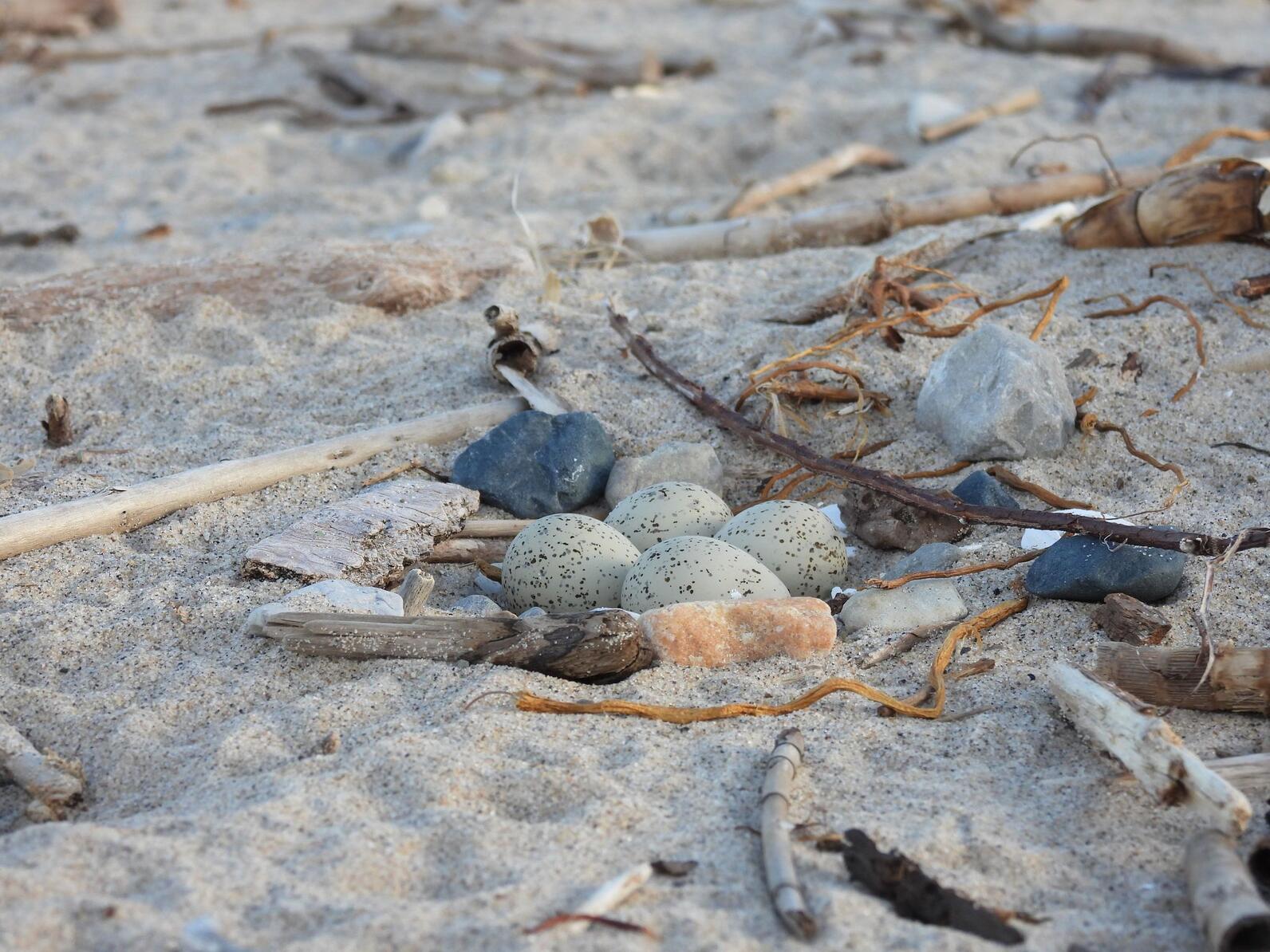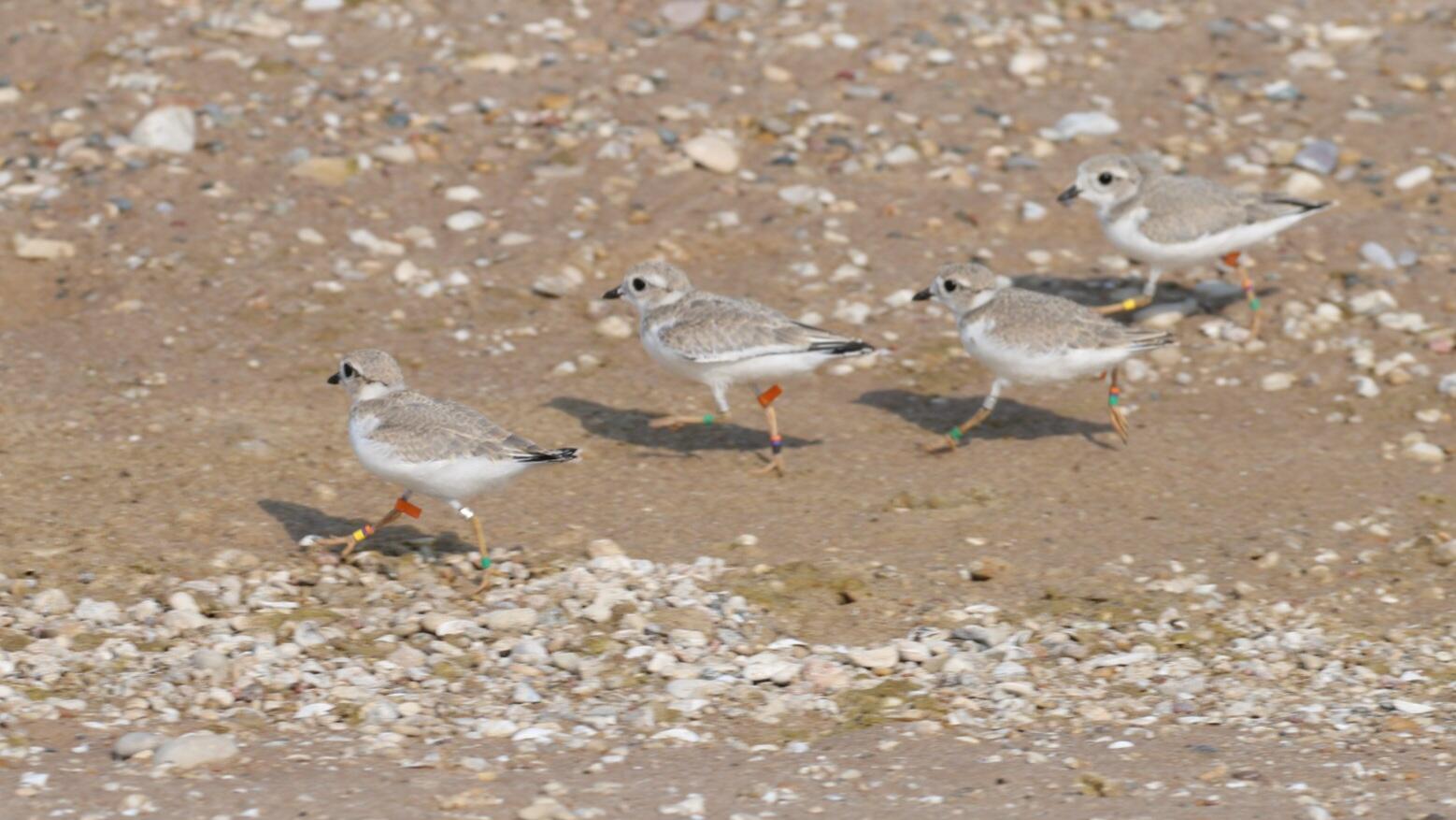GREEN BAY, WI - (August 28, 2024) In a promising sign for the recovery of the endangered Great Lakes Piping Plover, this spring and summer Audubon Great Lakes staff and volunteer monitors worked with U.S. Fish and Wildlife Service, Wisconsin Department of Natural Resources, and several other partners to monitor and protect nesting activities in lower Green Bay, Wisconsin. Through this collaborative effort, 10 Piping Plover fledglings were successfully produced at two breeding sites – the Cat Island Restoration Chain and Longtail Point.
This season, the Cat Island Restoration Chain and nearby Longtail Point saw a total of 10 fledglings produced from four nests. Six chicks fledged successfully in the wild while four chicks were reared in captivity and released. A new pair of Plovers nested at Longtail Point for the second year in a row, and second time in recorded history - a significant development for the region's efforts to recover this species.
In 2023, Longtail Point became home to a pair of nesting Piping Plovers for the first time in recorded history. This first pair of Plovers laid four eggs, which were unfortunately eaten by a predator before they hatched. The project team was hopeful that Piping Plovers would return to Longtail Point in 2024, and this occurred in mid-June when a new pair of Plovers was detected.
“I knew there was a chance I’d find Piping Plovers when I paddled out to Longtail Point especially because a few birds had apparently left the Cat Island Restoration Chain but was very pleasantly surprised to find two of our missing birds acting as a territorial pair,” said Jack Swelstad, Audubon Great Lakes volunteer Piping Plover monitor. “I was optimistic that they were interacting with each other and chasing other birds, and less than a week later another volunteer found their nest with a full clutch of eggs!”

This demonstrates that the Piping Plover population at the nearby Cat Island Restoration Chain which is approximately two miles from and within view of Longtail Point, is growing and radiating out to nearby areas of acceptable nesting habitat, a very important step in endangered species recovery.
“You never know if these endangered shorebirds will return to new nesting locations, but we were hopeful, especially with this year’s lower water levels in Green Bay as the result of a winter and spring with below average precipitation, exposing more sandy nesting habitat at Longtail Point,” said Tom Prestby, Conservation Manager, Wisconsin for Audubon Great Lakes. “This is a great sign for the small but growing population of Great Lakes Piping Plovers in lower Green Bay.”
This year’s nest at Longtail Point was in an area that many beachgoers annually utilize during the summer. After initial successful incubation by the pair after the nest was discovered in mid-June, staff and volunteer monitors observed that the male disappeared the night of July 4 and never returned. It is presumed that the male was possibly stressed by holiday celebrations close to the nest, and predated by a dog or natural predator, because abandonment by a male at this stage of incubation is extremely rare.
When one parent is lost, the fate of the nest is at stake. The nest's four eggs were collected by U.S. Fish and Wildlife Service when it was clear that the male was not returning. The eggs hatched and chicks were raised in captivity at the University of Michigan Biological Station until they reached fledging age. All four chicks were released at Sleeping Bear Dunes in Michigan in mid-August, just in time to migrate south to their wintering grounds, which they will be able to do by instinct.
“Even though the Longtail Point nest did not produce wild-fledged young this summer, the four captive-reared fledglings that were released contribute critically to the population,” said Jade Arneson, Biologist for U.S. Fish and Wildlife Service. “We hope they will return to nest in the Great Lakes next year.”

At the Cat Island Restoration Chain, three pairs of Piping Plovers produced six wild fledglings, up slightly from last year. “This ratio of two fledged chicks per pair surpasses our population recovery goal of 1.5 chicks per pair of nesting adult Plovers. This is a great achievement for the Wisconsin Piping Plover population and a testament to the hard work of our partnership and volunteer monitors,” said Arneson.
“As an active dredge disposal facility, Cat Island is closed to the public, so Piping Plovers are more likely to be successful there where human disturbance to them is minimal,” said Prestby. “Since we have more pairs nesting at Cat Island, they are competing for space and food, so some birds have started to use Longtail Point to nest and forage.”
Longtail Point is part of the Green Bay West Shores Wildlife Area, which is owned and managed by Wisconsin Department of Natural Resources (DNR). “While Longtail Point is open to the public, it’s important that beachgoers and visitors remember that Piping Plovers can be easily scared off when getting too close,” said Josh Martinez, Conservation Biologist for Wisconsin DNR. “We can all help keep these birds safe by sharing the shore, respecting posted areas, giving birds space, and keeping dogs on a leash during the nesting season.”
Since being listed as federally endangered in 1986 under the U.S. Endangered Species Act, Great Lakes Piping Plovers have made a slow but steady recovery across the Great Lakes thanks to the collaborative efforts of the Great Lakes Piping Plover Recovery Effort, partners, organizations, and volunteers, who have worked together to bring these sandy-colored shorebirds back from the brink of extinction.
Thanks to the collaborative conservation efforts, 2024 was a record-breaking nesting season, with 81 pairs of Piping Plovers observed across the Great Lakes region. This success is in part due to the population spreading outside of Michigan, remaining steady in Wisconsin, and recolonizing a site on Lake Superior and multiple sites on Lake Michigan in Illinois.
As we look to 2025, there is hope that these resilient birds will continue their slow but sure upward trajectory in the Great Lakes, including attempting to nest at Longtail Point again, reinforcing the importance of “sharing the shore” when we use locations that plovers call home.
About Audubon Great Lakes
The National Audubon Society protects birds and the places they need, today and tomorrow. Audubon works throughout the Americas using science, advocacy, education and on-the-ground conservation. State programs, nature centers, chapters and partners give Audubon an unparalleled wingspan that reaches millions of people each year to inform, inspire and unite diverse communities in conservation action. A nonprofit conservation organization since 1905, Audubon believes in a world in which people and wildlife thrive. Audubon Great Lakes is a regional office of Audubon, learn more at gl.audubon.org.




